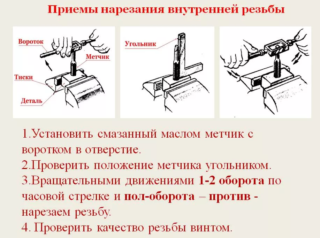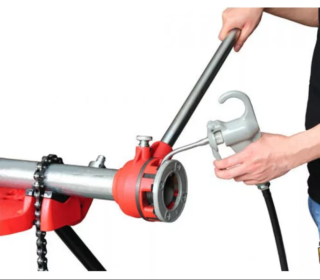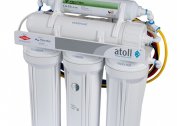Installation of a water supply system requires the assembly of individual elements into a single system. Metal pipes and valves are joined by a threaded connection. The method provides a strong and tight connection. For independent laying of communication, tools for threading water pipes will be required.
Types of thread on pipes
A thread is an alternation of protrusions and depressions on a surface located along a helical line. It is external and internal, left and right. Common types:
- pipe cylindrical;
- conical pipe;
- inch cylindrical (US standard);
- round;
- inch.
In installation plumbing, the first two types are usually used. They are used to connect water fittings:
- Cylindrical (G) - the profile is represented by an isosceles triangle with an apex of 55 °. The protrusions and depressions are rounded. Recommended for pipes up to 6 inches in diameter.
- Conical (R) - thread has a triangular profile, forms a taper of 1:16, is characterized by high tightness of the connection of parts.
Pipe threads are inch and metric, respectively, measured in inches and millimeters.
Necessary tools
 To perform the work, threading tools will be required:
To perform the work, threading tools will be required:
- Die or lerka - a device in the form of a nut made of hardened metal, has pointed cutting edges (cutters). In shape they are round, square, hexagonal. Types of dies: solid, sliding, split. For the removal of chips arranged holes.
- Klupp - tool based on a sliding die. The body, consisting of two parts, allows you to adjust the diameter of the cut. For convenience, a handle is arranged. Some models are supplemented with a ratchet, allowing rotational movements with one hand. The professional tool is equipped with an electric drive.
- Tap - a hardened steel screw having cutting edges. Consists of a working part and a shaft. The set includes devices for roughing and finishing work.
Additionally prepare auxiliary devices:
- tape measure and pencil - for measurements and marks;
- caliper - determines the diameter of pipes and devices.
The tools used must be of high quality, the metal of the cutters sharp and durable. When working with dies and taps you will need a vise.
Preparation for work
The area where you have to work with a thread-cutting device for water pipes is cleaned of rust, dirt, paint residues. Sandpaper is used. The surface should be cleaned to a metallic luster. The facet is chamfered. It is necessary to prepare grease for machining the pipe and cutting tool. To clean the chips, a rag is required.
Methods of threading a water pipe
 Cutting methods are divided into two types: manual and automatic. In the first case, a set of threading devices is required. For cutting external threads, die dies are used; for internal threads - taps. The dimensions of the tools are determined by reference tables. Automatic cutting takes place on machines or power tools. The method is accurate and suitable for pipes of any diameter. The machines milling and rolling threads.
Cutting methods are divided into two types: manual and automatic. In the first case, a set of threading devices is required. For cutting external threads, die dies are used; for internal threads - taps. The dimensions of the tools are determined by reference tables. Automatic cutting takes place on machines or power tools. The method is accurate and suitable for pipes of any diameter. The machines milling and rolling threads.
Die cutting
The choice of tool type depends on quality requirements. The best result is achieved by using a solid die, which has high rigidity. The disadvantage of this device is its quick wear. Spring-loaded dies (with a cut in one of the axial holes) allow you to change the diameter of the thread within 0.3 mm.Their stiffness is reduced, the incisors last longer, but the purity of the threads is lost.
The prepared pipe is clamped in a vice. The die is placed in the holder and fixed with screws. Grease is applied to the treated area and cutters. The tool is put on the pipe at a right angle. The rotation is smooth, clockwise. After making several turns, the chips are removed and lubrication is resumed. For high-quality cutting after a rough die, a fine one is used. Finished thread is cleaned with rags.
Using a clapper
Using a pipe plug is more convenient than dies. A tool is more expensive, but for a large amount of work it is better to choose it. Klupp gives a clean turn, sliding design allows you to adjust the diameter of the thread. Installation of guides reduces the risk of distortions, facilitates the cutting process. If a ratchet is included in the structure, a ratchet wheel is placed near the die. When it is rotated, the tool head moves. Ratchet is indispensable in cramped working conditions.
The pipe is clamped in a vice, a small area is left. A short protruding part will not allow the metal to bend from the applied efforts. The pipe and cutters are lubricated with machine oil. The protruding part is inserted into the guide of the screwdriver. Cutting takes place in short rotational movements. Turn back periodically to cut chips. In the process, lubricant is added. When threading water pipes, it is important to monitor the number of turns.
Using an electric tool allows you to cut in a few seconds. Replaceable heads with cutters are selected for the desired pipe diameter. The work is not only fast, but also high-quality.
Work tap
 The internal thread is performed by a tap. Its diameter should be slightly larger than the pipe. When working, it is recommended to use a set of two to three parts. They perform roughing and finishing cutting. The first tool carries out the main work, removing up to 70% of the chips. The finishing tap has a small intake part and a full cutting profile. Tools are distinguished by grooves on the shank:
The internal thread is performed by a tap. Its diameter should be slightly larger than the pipe. When working, it is recommended to use a set of two to three parts. They perform roughing and finishing cutting. The first tool carries out the main work, removing up to 70% of the chips. The finishing tap has a small intake part and a full cutting profile. Tools are distinguished by grooves on the shank:
- one is black;
- two are medium;
- three - fine.
The inside of the pipe requires cleaning and lubrication. The tap is inserted vertically, the shank is fixed in the head. The rotation is clockwise. When working with soft metal, the tool is periodically turned out and the chips are cleaned. Be sure to apply grease. After completion of the work, the thread quality is checked.
The main reasons for marriage
The cause of marriage in work is the carelessness of the worker or the use of low-quality tools. Common pipe cutting defects when working with a tap or die:
- Torn thread - the problem occurs when using a dull die, untimely chip removal, insufficient lubrication.
- Incomplete thread - the diameter of the hole for the thread exceeds the recommended one.
- Misalignment of screw grooves - incorrect installation of the die or tap.
- Failure of the thread is the reason for clogging the grooves with chips, poor tool quality, the diameter of the pipe is larger than intended.
- Tap breakage - excessive force in a narrow hole, insufficient chip removal, lack of lubrication.
Self-preparation of parts for a threaded connection is quite available with a tool. For the work to be done efficiently, you must follow the rules. The use of a sharp tool and accuracy compensate for the lack of professional skills.




